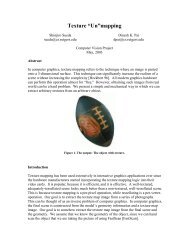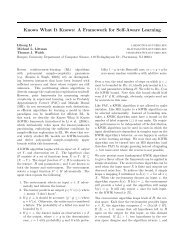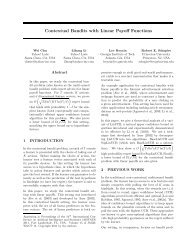Composition theorems in communication complexity
Composition theorems in communication complexity
Composition theorems in communication complexity
You also want an ePaper? Increase the reach of your titles
YUMPU automatically turns print PDFs into web optimized ePapers that Google loves.
Us<strong>in</strong>g the idea of f<strong>in</strong>d<strong>in</strong>g a certificate of the high approximate degree by duality [She09,SZ09b],<br />
we have the follow<strong>in</strong>g fact analogous to Lemma 1.<br />
Lemma 2. For a function f : S → C and a subspace Φ of L C (S), if d(f, span(Φ)) = δ, then<br />
there exists a function h s.t.<br />
ĥ i = 0, ∀ψ i ∈ Φ (1)<br />
∑<br />
|h(g)| ≤ 2, (2)<br />
g∈G<br />
| ∑ g∈G<br />
f(g)h(g)| > δ (3)<br />
Us<strong>in</strong>g the lemma, we can prove the Theorem 11.<br />
Proof. (of Theorem 11) By the regularity property, we know that when (x, y) runs over X×Y ,<br />
g(x, y) runs over S exactly K times where K = MN/|G|. Consider B = 1 K [h(g(x, y))] x,y, h<br />
obta<strong>in</strong>ed by Lemma 2; we want to apply Proposition 1 and Theorem 4 by us<strong>in</strong>g this B. First,<br />
‖B‖ 1 = 1 ∑<br />
|h(g(x, y))| = ∑ |h(g)| ≤ 1. (4)<br />
K<br />
x,y<br />
g∈G<br />
Also,<br />
|〈A, B〉| = 1 K | ∑ x,y<br />
f(g(x, y))h(g(x, y))|<br />
= | ∑ g∈G<br />
f(g)h(g)| > δ<br />
Now we need to compute<br />
Note that<br />
‖B‖ = 1 ∥ [<br />
K<br />
∑<br />
∥<br />
ĥ i χ i (g(x, y))] x,y∥.<br />
χ i∈Hard<br />
[ψ i (g(x, y))] † x,y[ψ j (g(x, y))] x,y = [ ∑ x<br />
ψ i (g(x, y))ψ j (g(x, y ′ ))] y,y ′<br />
and<br />
[ψ i (g(x, y))] x,y [ψ j (g(x, y))] † x,y = [ ∑ y<br />
ψ i (g(x, y))ψ j (g(x ′ , y))] x,x ′.<br />
Thus the orthogonality condition implies that<br />
[ψ i (g(x, y))] † x,y[ψ j (g(x, y))] x,y = [ψ i (g(x, y))] x,y [ψ j (g(x, y))] † x,y = 0<br />
for all i ≠ j. Now as <strong>in</strong> [She09], we can use the max bound<br />
‖B‖ = 1 K<br />
max<br />
∥ ∥ ∥ĥi [ψ i (x, y)] x,y i:ψ i∈Ψ Hard<br />
≤ 1 K<br />
max |ĥi|<br />
i:ψ i∈Hard<br />
≤ 1 max<br />
K|G| ψ i∈Hard<br />
max<br />
ψ i∈Hard<br />
∥<br />
∥ [ψi (x, y)] x,y (<br />
max |ψ i (g)| · ∥∥ ∥) [ψi (x, y)] x,y .<br />
g<br />
where the last <strong>in</strong>equality is due to Eq. (5) and Eq. (4). F<strong>in</strong>ally note K|G| = MN to complete<br />
the proof.


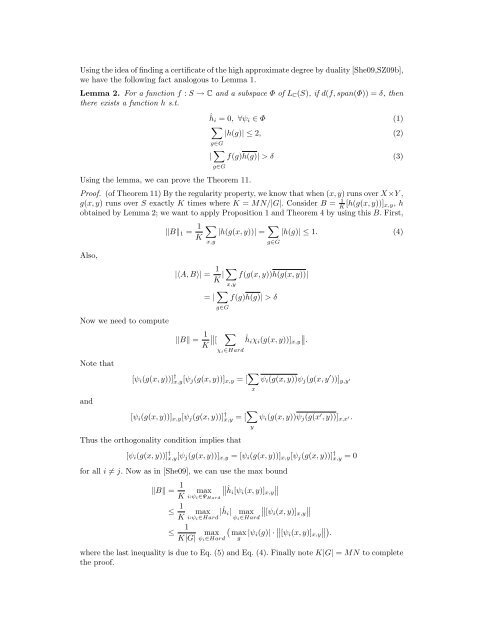
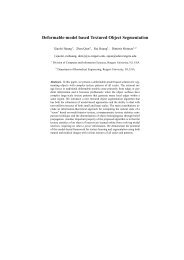
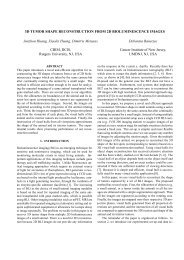
![Twitter[PDF]](https://img.yumpu.com/25710531/1/190x143/twitterpdf.jpg?quality=85)

